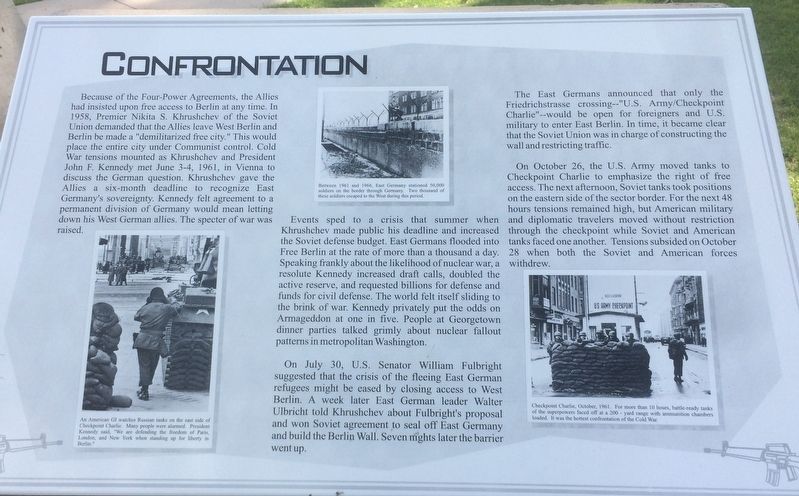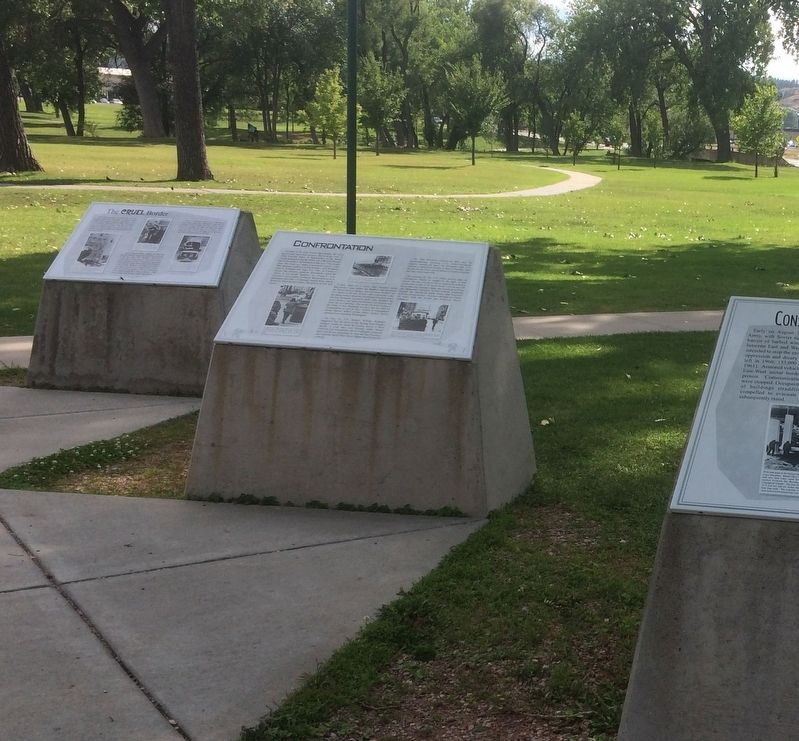Rapid City in Pennington County, South Dakota — The American Midwest (Upper Plains)
Confrontation
The Berlin Wall Memorial
Because of the Four-Power Agreements, the Allies had insisted upon free access to Berlin at any time. In 1958, Premier Nikita S. Khrushchev of the Soviet Union demanded that the Allies leave West Berlin and Berlin be made a "demilitarized free city." This would place the entire city under Communist control. Cold War tensions mounted as Khrushchev and President John F. Kennedy met June 3-4, 1961, in Vienna to discuss the German question. Khrushchev gave the Allies a six-month deadline to recognize East Germany's sovereignty. Kennedy felt agreement to a permanent division of Germany would mean letting down his West German allies. The specter of war was raised.
Events sped to a crisis that summer when Khrushchev made public his deadline and increased the Soviet defense budget. East Germans flooded into Free Berlin at the rate of more than a thousand a day. Speaking frankly about the likelihood of nuclear war, a resolute Kennedy increased draft calls, doubled the active reserve, and requested billions for defense and funds for civil defenses. The world felt itself sliding to the brink of war. Kennedy privately put the odds on Armageddon at one in five. People at Georgetown dinner parties talked grimly about nuclear fallout patterns in metropolitan Washington.
On July 30, U.S. Senator William Fulbright suggested that the crisis of the fleeing East German refugees might be eased by closing access to West Berlin. A week later East German leader Walter Ulbricht told Khrushchev about Fulbright's proposal and won soviet agreement to seal off East Germany and build the Berlin Wall. Seven nights later the barrier went up.
The East Germans announced that only the Friedrichstrasse crossing - "U.S. Army/Checkpoint Charlie" -would be open for foreigners and U.S. military to enter East Berlin. In time, it became clear that the Soviet Union was in charge of construction the wall and restricting traffic.
On October 26, the U.S. Army moved tanks to Checkpoint Charlie to emphasize the right of free access. The next afternoon, Soviet tanks took positions on the eastern side of the sector order. For the next 48 hours tensions remained high, but American military and diplomatic travelers moved without restriction through the checkpoint while soviet and American tanks faced one another. Tensions subsided on October 28 when both the Soviet and American forces withdrew.
Between 1961 and 1966, East Germany stationed 50,000 soldiers on the border through Germany. Two thousand of these soldiers escaped to the West during this period.
Checkpoint Charlie, October, 1961. For more than 10 hours, battle-ready tanks of the superpowers faced off at a 200 - yard range with ammunition chambers loaded. It was the hottest confrontation of the Cold War.
Erected 1996.
Topics and series. This historical marker is listed in this topic list: War, Cold. In addition, it is included in the Berlin Wall, and the Former U.S. Presidents: #35 John F. Kennedy series lists. A significant historical year for this entry is 1958.
Location. 44° 5.171′ N, 103° 13.67′ W. Marker is in Rapid City, South Dakota, in Pennington County. Marker is on Mount Rushmore Road. The Berlin Wall memorial is located in Memorial Park. Touch for map. Marker is at or near this postal address: 434 N Mt Rushmore Rd, Rapid City SD 57701, United States of America. Touch for directions.
Other nearby markers. At least 8 other markers are within walking distance of this marker. Construction of the Wall (here, next to this marker); Celebrating Victory (here, next to this marker); A City Divided (here, next to this marker); The Berlin Wall Memorial (here, next to this marker); The Cruel Border (a few steps from this marker); The American Commitment (a few steps from this marker); Berlin Wall Segments (a few steps from this marker); Tank Traps (a few steps from this marker). Touch for a list and map of all markers in Rapid City.
Related markers. Click here for a list of markers that are related to this marker.
Also see . . . The Berlin Wall Memorial. (Submitted on July 9, 2019, by Ruth VanSteenwyk of Aberdeen, South Dakota.)
Credits. This page was last revised on July 19, 2019. It was originally submitted on July 9, 2019, by Ruth VanSteenwyk of Aberdeen, South Dakota. This page has been viewed 144 times since then and 9 times this year. Last updated on July 13, 2019, by Ruth VanSteenwyk of Aberdeen, South Dakota. Photos: 1, 2, 3. submitted on July 9, 2019, by Ruth VanSteenwyk of Aberdeen, South Dakota. • Bill Pfingsten was the editor who published this page.


